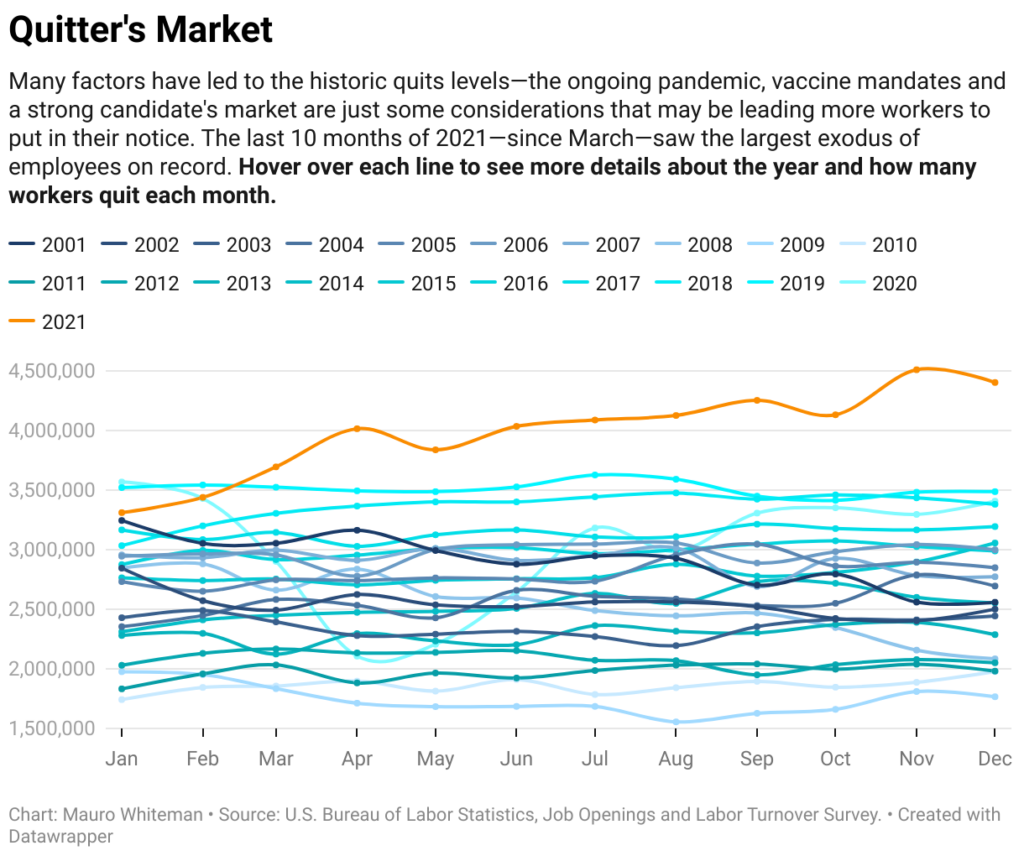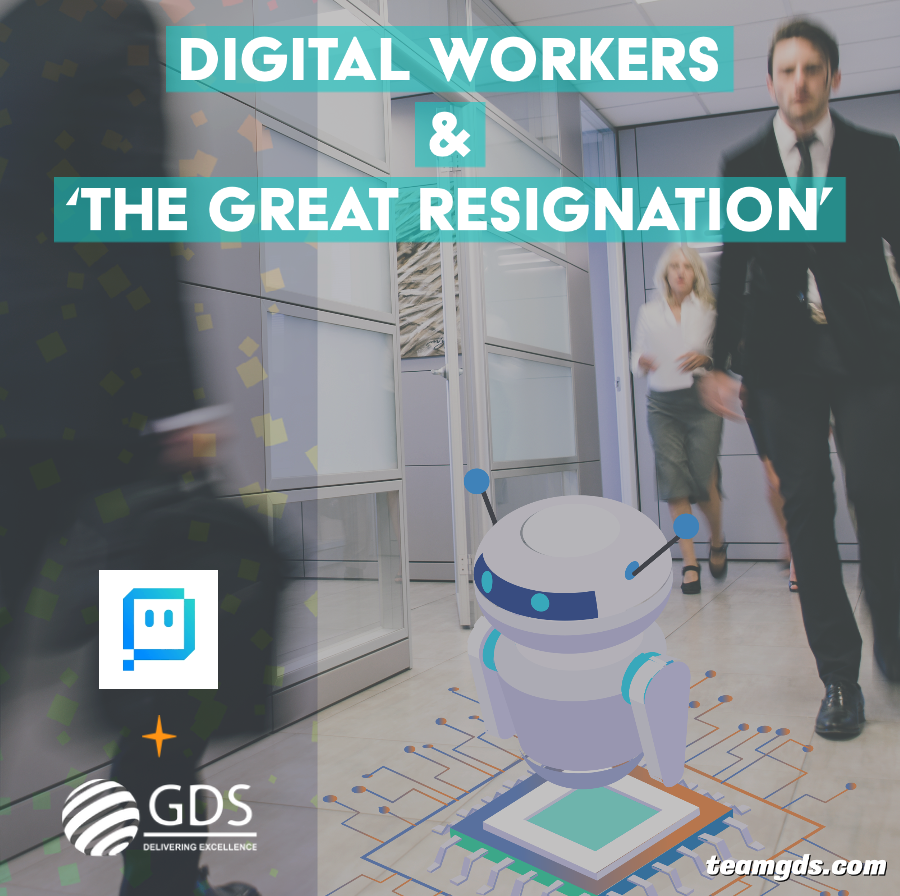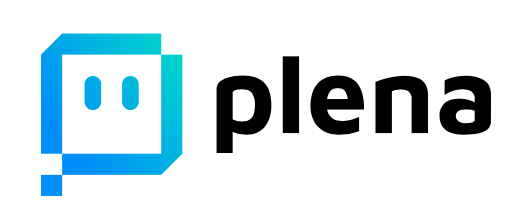Digital Workers & 'the Great Resignation'
Digital Workers & 'the Great Resignation'
Author: Stephanie Bonnett
The Problem at Hand: Staffing Shortages
Midway through the global pandemic, Covid-19, companies began experiencing what has been dubbed ‘the Great Resignation’. According to the US Bureau of Labor Statistics, 47.4 million workers voluntarily left their jobs in 2021 alone. Most businesses have been impacted in some way by this mass exodus. Finding talent with the correct skillset to do the work that needs to be done continues to be a significant challenge for most companies, irrespective of their size, location, or industry. In addition to this workplace attrition, Covid-19 has caused widespread and compounding issues of ill health, childcare issues, and a pervasive feeling that employers aren’t doing enough to keep employees safe.
The Problem at Hand: Staffing Shortages
Midway through the global pandemic, Covid-19, companies began experiencing what has been dubbed ‘the Great Resignation’. According to the US Bureau of Labor Statistics, 47.4 million workers voluntarily left their jobs in 2021 alone. Most businesses have been impacted in some way by this mass exodus. Finding talent with the correct skillset to do the work that needs to be done continues to be a significant challenge for most companies, irrespective of their size, location, or industry. In addition to this workplace attrition, Covid-19 has caused widespread and compounding issues of ill health, childcare issues, and a pervasive feeling that employers aren’t doing enough to keep employees safe.


Digital Workers
Much work and thoughtful change is needed to address the larger issue, but the purpose of this conversation is to tackle one critical aspect that can be solved now. The solution is efficient, accurate, affordable, and available to go to work in a matter of weeks: Digital workers. While automation is a hot topic, robotic process automation (RPA) is blazing hot and growing fast. Gartner expects the RPA spend to reach $11 billion in 2027. Indeed, digital workers are becoming a standard for accounting and finance teams.
Digital Workers
Much work and thoughtful change is needed to address the larger issue, but the purpose of this conversation is to tackle one critical aspect that can be solved now. The solution is efficient, accurate, affordable, and available to go to work in a matter of weeks: Digital workers. While automation is a hot topic, robotic process automation (RPA) is blazing hot and growing fast. Gartner expects the RPA spend to reach $11 billion in 2027. Indeed, digital workers are becoming a standard for accounting and finance teams.
Plena RPA
GDS’s commitment to providing cloud-based solutions to benefit their customers led them to partner with Plena to deliver digital workers, or bots. Plena’s platform is specifically designed to service mid-market clients, being both affordable and quick to implement. Plena bots use the keyboard, mouse, and screen controls to perform tasks, just like a human would only faster and without mistakes. Plena empowers companies to offload manual, repetitive tasks like accounts receivable, accounts payable, and reconciliations to bots, working in the background while their human workers perform more meaningful and fulfilling tasks. More specific to this conversation, bots don’t quit, they don’t get sick, they don’t get tired, they don’t take vacations, and they are impervious to burnout, career growth, or seeking better opportunities elsewhere. Bots just blast through the work with 100% accuracy then send an exception report to the process owner with any transactions that fall outside of their programmed logic.
Plena RPA
GDS’s commitment to providing cloud-based solutions to benefit their customers led them to partner with Plena to deliver digital workers, or bots. Plena’s platform is specifically designed to service mid-market clients, being both affordable and quick to implement. Plena bots use the keyboard, mouse, and screen controls to perform tasks, just like a human would only faster and without mistakes. Plena empowers companies to offload manual, repetitive tasks like accounts receivable, accounts payable, and reconciliations to bots, working in the background while their human workers perform more meaningful and fulfilling tasks. More specific to this conversation, bots don’t quit, they don’t get sick, they don’t get tired, they don’t take vacations, and they are impervious to burnout, career growth, or seeking better opportunities elsewhere. Bots just blast through the work with 100% accuracy then send an exception report to the process owner with any transactions that fall outside of their programmed logic.
GDS
In partnership with Plena, GDS designs and develops bots to take over tedious manual processes, enabling clients to re-purpose staff and grow without the necessity to bring on additional, hard to find employees. Just as GDS works with more than one ERP, Plena bots are ERP/accounting system agnostic, currently working with 90+ systems. If your business has human assets currently spending hours on busywork, reach out today to explore if RPA is right for your business and identify what processes would benefit most from a Plena bot. With the Plena / GDS model, you can expect to be live within 30 days of contract signature!
GDS
In partnership with Plena, GDS designs and develops bots to take over tedious manual processes, enabling clients to re-purpose staff and grow without the necessity to bring on additional, hard to find employees. Just as GDS works with more than one ERP, Plena bots are ERP/accounting system agnostic, currently working with 90+ systems. If your business has human assets currently spending hours on busywork, reach out today to explore if RPA is right for your business and identify what processes would benefit most from a Plena bot. With the Plena / GDS model, you can expect to be live within 30 days of contract signature!






